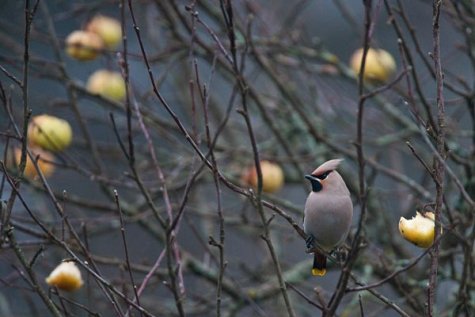Waxwings and apple trees
Photo: Arne Ader
Translation: Liis
Siidisaba
| Waxwing |
Siidisaba
|
Bombycilla garrulus |
Waxwings rarely nest in Estonia, but it happens occasionally. Passing migrants from Finland and Karelia have been seen for a week already. The largest numbers of the passing migrants come in November-December. As winterers in Estonia some twenty thousand may stay and we often see them in cities.
The conspicuous birds carry on with their doings in flocks. They are usually not afraid of humans; only when they are disturbed the company flies off to a neighbouring tree. Since they nest in the tundra and forest zones they don’t often come in contact with people; the confidence stems from this.
About the differences between the young and the adult birds this much: the young birds lack the black patch on the throat and the gloss of the plumage is duller. The adult birds have a silky sheen; the basic colours of the plumage are reddish-brown and grey. The eyes have a black band, and under the throat is a patch of the same colour. The beak is strong, with a slightly curved tip. All have the proud crest. Wing feathers black, with yellow and white spots; the flight feathers have yellow tips as has the tip of the tail. Quite colourful things.
They forage hungrily. Apples still left in the trees are particularly tempting. A flock can clean out a rowan, juniper, wild rose, aronia or hawthorn in a very short time, leaving the ground under the trees or bushes thickly covered with berry fragments and leftovers. Such „signatures“ are quite often to be seen on the ground.
In flight the birds are accompanied by a typical, continuous trilling sound.









